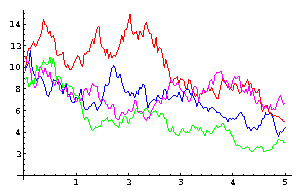MATH 194: INTRODUCTION TO THE MATHEMATICS OF FINANCE (WINTER 2012)

Professor:
Professor R. J. Williams, Office: AP&M 6121.
Professor's Office Hours: M, W 1-1.50pm.
Lecture Time: M 6-6.50pm (PH 103), W 6-6.50pm (PH103), W 7-7.50pm (AP&M B412)
Lecture Place: Peterson Hall 103 and AP&M B412.
Section Times: Th 11-11.50am, 12-12.50pm.
Section Place: U413 1.
Teaching Assistant: David Lipshutz, AP&M 6343.
TA Office Hours: Monday 2.30pm-3.30pm, Wednesday 1.30pm-3.30pm.
DESCRIPTION:
This course provides an introduction to the mathematics of
some financial models.
The aim is to provide students
with an introduction to some basic probabilistic models of finance and associated mathematical machinery. The course focusses largely on
financial derivatives and related mathematics.
The
course begins with the development of the
basic ideas of hedging and pricing of
derivatives in the discrete (i.e., discrete time and discrete state) setting of
binomial tree models.
The famous Black-Scholes option pricing formula is derived
as a limit from these models.
Then a general discrete finite market model is introduced, and the
fundamental theorems of asset pricing are proved in this setting.
Tools from probability
such as conditional expectation, filtration,
(super)martingale, equivalent martingale
measure, and
martingale representation are all introduced and used
in this discrete setting.
This course requires a solid background in
probability, preferably at the level of the undergraduate
probability course Math 180A at UCSD, or at a bare minimum Math 183.
It also uses a certain amount of geometric linear algebra,
so it is a good idea to review background from Math 20F.
The graduate course, Math 294, which has a similar title, is at a more advanced level and has much more emphasis on continuous time models which use measure theory.
PREREQUISITES: Math 20D, Math 20F or Math 31AH, and Math 180A or Math 183.
TEXT: No specific text is required.
Some summary notes will be provided to accompany the course.
To access the notes, click here (you will need a password
to access this site -- this will be given in class).
OTHER REFERENCES:
F. AitSahlia and K. L. Chung, Elementary Probability Theory, Springer,
Fourth Edition.
M. Capinski and T. Zastawniak, Mathematics for finance: an introduction to
financial engineering, Springer, 2010.
J. Cvitanic and F. Zapatero,
Economics and Mathematics of Financial Markets, MIT Press, 2004.
T. S. Y. Ho and S. B. Lee, The Oxford Guide to Financial Modeling,
Oxford, 2004.
J. Hull, Options, Futures and other Derivative Securities, Prentice Hall.
S. Pliska, Introduction to Mathematical Finance,
Blackwell, 1998.
S. Ross, An Introduction to Mathematical Finance, Options and other topics,
Cambridge University Press, 1999.
J. Stampfli and V. Goodman, The Mathematics of Finance: Modeling and
Hedging, Brooks/Cole, Pacific Grove, CA, 2001.
P. Wilmott et al., The Mathematics of Financial Derivatives,
Cambridge University Press, 1995.
Article on incomplete markets by Jeremy Staum,
in Handbooks in OR and MS, Vol. 15, 2008, Elsevier.
OTHER RESOURCES:
Linear algebra lectures by Gil Strang (MIT). You may find lecture 1, 9, 14 helpful
in reviewing geometric aspects of linear algebra.
WIKEPEDIA AND OTHER LINKS:
Forward contracts
Futures contracts
Options
Swaps
Credit Default Swaps
Scholes-Merton Nobel
Prize citation, 1997.
Myron Scholes' Nobel Lecture, 1997.
Robert Merton's Nobel Lecture, 1997.
An article by Marsh and Kobayashi
on the Contributions of Black, Merton and Scholes to the financial services industry, June 2001.
Darrell Duffie's website with articles on various
financial market policy issues
Article by Jeremy Kress in
Harvard Journal on Legislation, 2011, related to clearinghouses for swaps.`
NEWS ARTICLES:
Don't Blame the Quants, by Steven Shreve, Forbes Magazine, October 2008.
"The End of the Financial World as We Know It" and
"How to Repair a Broken Financial World",
by Michael Lewis and David Einhorn, New York Times, Jan 4, 2009.
Capitalist Fools, by Joseph Stiglitz, January 2009, Vanity Fair.
After Sure-Bet Investment Fails, a Bank Contends It Was Duped, by Vikas Bajaj, New York Times, January 20, 2009.
Obama plans fast action to tighten financial rules, by Stephen Labaton, New York Times,
January 25, 2009.
Time to unravel the knot of credit default swaps, by Gretchen Morgenson, New York Times, January 25, 2009.
Six errors on the path to the financial crisis,
by Alan S. Blinder, New York Times, January 25, 2009.
NPR "This American Life" Program on the subprime mortgage crisis.
New York Times Article about current use
of credit default swaps, January 30, 2012.
HANDOUT:
For the course handout, click here.
HOMEWORK: Homework will generally be given weekly.
Homework will be due by
Friday, noon in the TA homework box.
Click here to go to the homework.
EXAMS: There will be one midterm (in class) exam and a final exam. In class exam: Wed, Feb 15, 2012. Final exam: Wed, March 21, 2012, 7-10pm.
The final on Wednesday, March 21 will be from 7pm to 10pm in PH103.
The final will be an overall test of the material covered in the lectures,
reading and homework for the whole quarter.
Please bring your student ID, a blue book or two, and pens/pencils to write with.
You may bring a single 8.5"x11" sheet of paper with writing on both sides of it to the exam.
No books or other notes are allowed.
You may bring a calculator.
Make sure to justify your answers (credit will not be given for "inspired'' answers).
Remember that part of each problem is to set it up and to arrive at the answer by a progression of logical steps.
Please start each problem on a new page, write legibly, and put your name and section number on your blue book.
Review session: Sunday, March 18, 3pm, Calculus Lab (B402A).
TA office hours in finals week: Tuesday 2-4pm, AP&M 6343.
Professor office hours in finals week: Monday, 3.30-4.30pm, Wednesday, 2-3pm.
LINKS TO RELATED WEB SITES
Please direct any questions to
Professor Ruth J. Williams, email:
williams at math dot ucsd dot edu
 Last updated January 8, 2012.
Last updated January 8, 2012.
